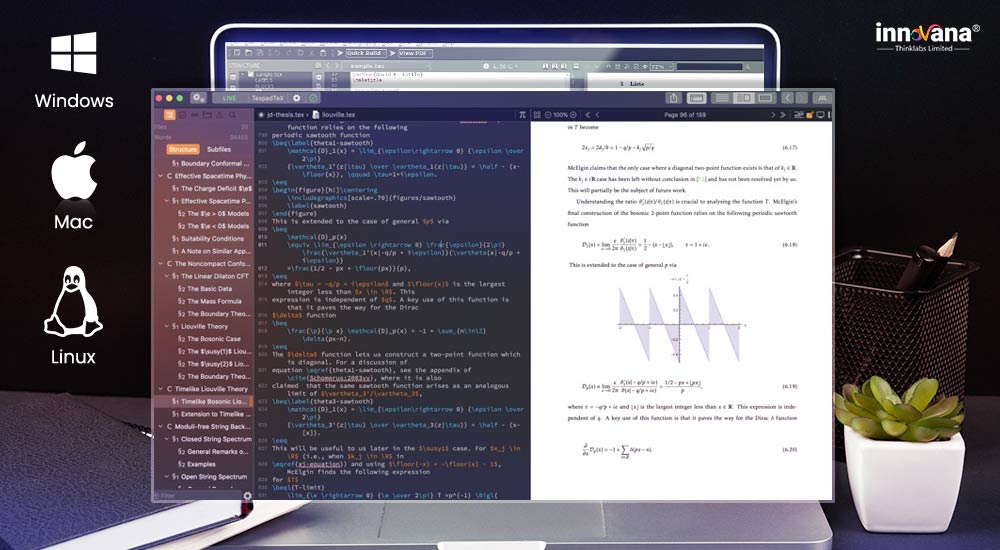
Having said that, what I love about it is that how easy it’s to create LaTeX documents without worrying about formatting details or design attributes. You also have access to many algorithms, theorems, and arrays of equations. With its advanced mathematical tools, you can visually drag and drop equations and edit them right there. The automatic index creation is a unique feature that you will only find on LyX. In addition, you can also author scientific papers with reference lists and citations. Besides that, you have support for academic article referencing, link overlay and ability to create a master thesis using branched out nodes. While many prefer LyX for mathematical documents, you can also create a structured novel or script using its advanced markup tools. The app uses many flexible tools like integrated equation editor and reference indexing to create LateX documents seamlessly. It emphasizes on the WYSIWYM writing approach with a simple GUI based interface. It is an open-source editor and it’s available on a number of platform including Windows, macOS, and Linux.


LyX is among the most popular LaTeX editors right now with support for many modern and unique features. Key Features: Integrated LaTeX environment for Windows apps, Auto-completion, Complete UTF-8 support, Document navigator, Library of LaTeX snippets, Syntax Highlighting, Spell Checking and more. To sum up, if you are a Windows user, TeXnicCenter is one of the best LaTeX editors that you can use in 2022 and you don’t have to look any further. It goes without saying that TeXnicCenter has all the common features like syntax highlighting, bracket matching and spell checking. What I love about TeXnicCenter is that it has pre-defined LaTeX snippets which makes it easy to create complex formula and documentation particularly for computer scientists. Overall, TeXmaker is one of the best LaTeX editors for Linux, Mac, and Windows. Keyboard short-cuts are abundant for TeXmaker and it makes the overall experience with this tool pretty worthwhile. This tool is also great for creating a structured Bibliography section of your document. Parts/sections of your documents could be easily folded/unfolded using TeXmaker. Another key feature of TeXmaker is the way it allows users to track errors during the compilation stage.Īll warnings and errors are displayed to let the user take the needed action regarding the same. Once the groundwork of your document layout is set up using TeXmaker, the document can now be compiled to get it extracted as a PDF, HTML or ODF file format. Inserting Tables, Math formula, cross-references, pictures, etc is pretty straightforward with TeXmaker. The ‘Structure View’ allows users to streamline their documents into separate sections, labeling each one in the process. TeXmaker also allows users to set-up the spell-checking and other document layout settings through the ‘Quick start’ window. To get started with TeXmaker, its configuration window allows users to set-up all the basic settings of their LaTeX document before starting work on it. This tool is available for all major platforms and possesses features that make a great case for any LaTeX text editor. If you like using open-source apps, TeXmaker is one of the most popular, open-source, multi-platform solution for LaTeX editing. If that’s what you’re looking for you should check out some of the best text editors instead. Note: LaTeX editors aren’t meant for basic text editing.

Mathematical equations are exceptionally handled by these editors and they were the primary reasons leading to its development in the first place.
#Latex editor windows preview pdf#
These tools allow users to define formatting of text before hand through markup-level instructions and once the content is inserted, the document is ready to be exported as a PDF or any other file format.

For people who have to deal with scientific papers and publishing, with a lot of mathematical equations thrown into the mix, LaTeX text editors are pretty much the industry standard. Quite similar to HTML in its formatting, LaTeX is one of the most commonly used text editor in the academia. Still don’t get what this is all about? In simple terms, LaTeX (pronounced Lay-tek), is a markup level text editing tool that separates the word formatting from the content entry task.


 0 kommentar(er)
0 kommentar(er)
